2014 NISSAN VERSA NOTE ignition
[x] Cancel search: ignitionPage 346 of 372
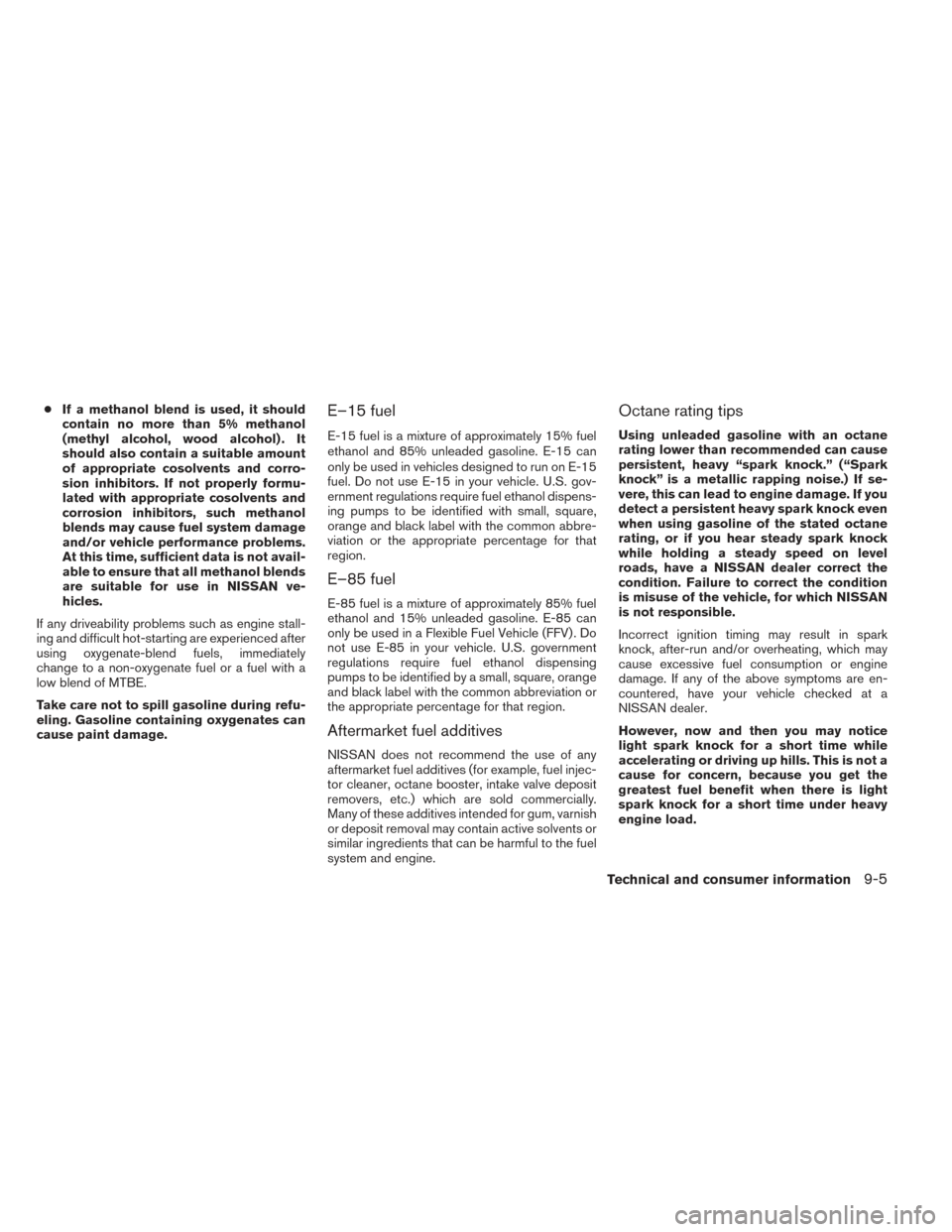
●If a methanol blend is used, it should
contain no more than 5% methanol
(methyl alcohol, wood alcohol) . It
should also contain a suitable amount
of appropriate cosolvents and corro-
sion inhibitors. If not properly formu-
lated with appropriate cosolvents and
corrosion inhibitors, such methanol
blends may cause fuel system damage
and/or vehicle performance problems.
At this time, sufficient data is not avail-
able to ensure that all methanol blends
are suitable for use in NISSAN ve-
hicles.
If any driveability problems such as engine stall-
ing and difficult hot-starting are experienced after
using oxygenate-blend fuels, immediately
change to a non-oxygenate fuel or a fuel with a
low blend of MTBE.
Take care not to spill gasoline during refu-
eling. Gasoline containing oxygenates can
cause paint damage.E–15 fuel
E-15 fuel is a mixture of approximately 15% fuel
ethanol and 85% unleaded gasoline. E-15 can
only be used in vehicles designed to run on E-15
fuel. Do not use E-15 in your vehicle. U.S. gov-
ernment regulations require fuel ethanol dispens-
ing pumps to be identified with small, square,
orange and black label with the common abbre-
viation or the appropriate percentage for that
region.
E–85 fuel
E-85 fuel is a mixture of approximately 85% fuel
ethanol and 15% unleaded gasoline. E-85 can
only be used in a Flexible Fuel Vehicle (FFV) . Do
not use E-85 in your vehicle. U.S. government
regulations require fuel ethanol dispensing
pumps to be identified by a small, square, orange
and black label with the common abbreviation or
the appropriate percentage for that region.
Aftermarket fuel additives
NISSAN does not recommend the use of any
aftermarket fuel additives (for example, fuel injec-
tor cleaner, octane booster, intake valve deposit
removers, etc.) which are sold commercially.
Many of these additives intended for gum, varnish
or deposit removal may contain active solvents or
similar ingredients that can be harmful to the fuel
system and engine.
Octane rating tips
Using unleaded gasoline with an octane
rating lower than recommended can cause
persistent, heavy “spark knock.” (“Spark
knock” is a metallic rapping noise.) If se-
vere, this can lead to engine damage. If you
detect a persistent heavy spark knock even
when using gasoline of the stated octane
rating, or if you hear steady spark knock
while holding a steady speed on level
roads, have a NISSAN dealer correct the
condition. Failure to correct the condition
is misuse of the vehicle, for which NISSAN
is not responsible.
Incorrect ignition timing may result in spark
knock, after-run and/or overheating, which may
cause excessive fuel consumption or engine
damage. If any of the above symptoms are en-
countered, have your vehicle checked at a
NISSAN dealer.
However, now and then you may notice
light spark knock for a short time while
accelerating or driving up hills. This is not a
cause for concern, because you get the
greatest fuel benefit when there is light
spark knock for a short time under heavy
engine load.
Technical and consumer information9-5
Page 349 of 372
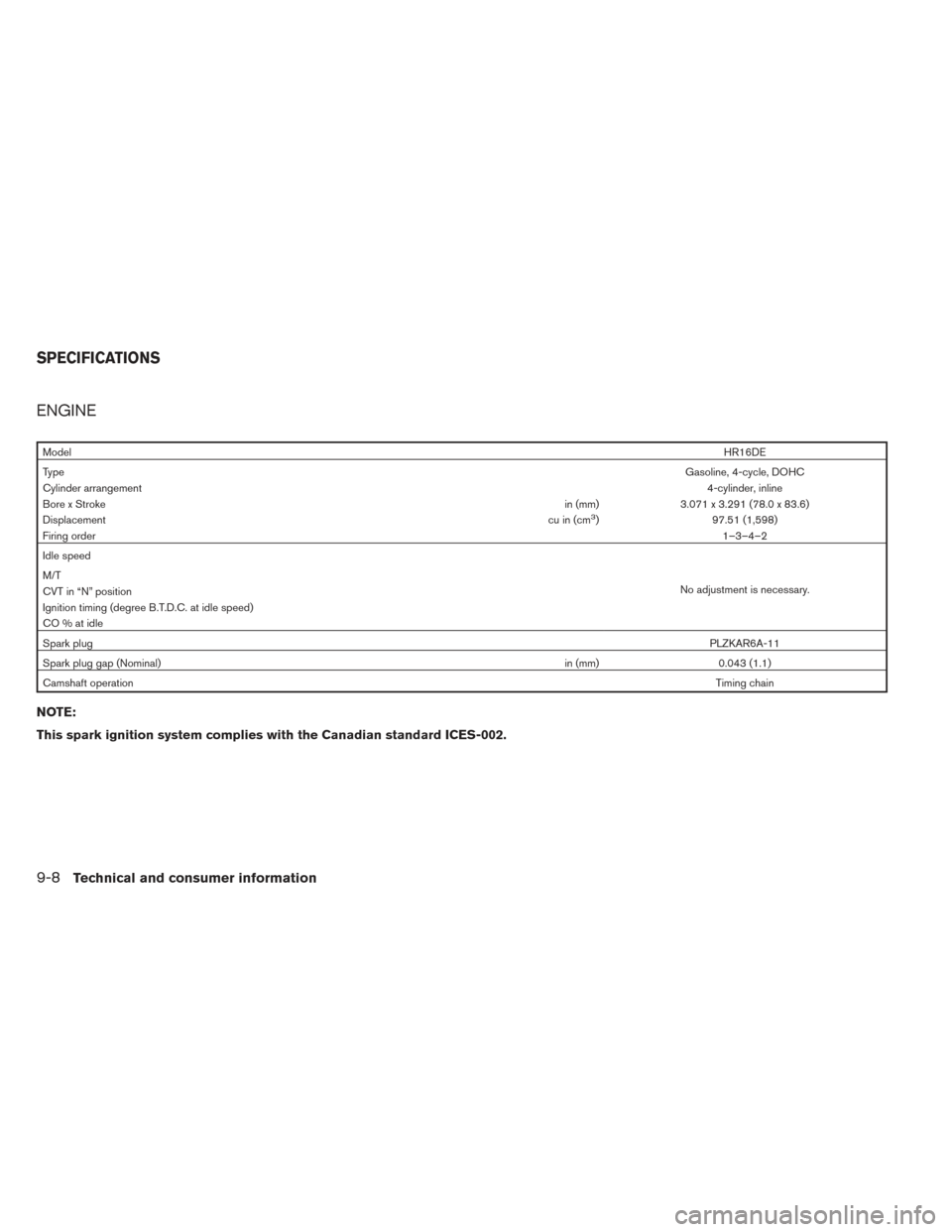
ENGINE
ModelHR16DE
Type Gasoline, 4-cycle, DOHC
Cylinder arrangement 4-cylinder, inline
Bore x Stroke in (mm)3.071 x 3.291 (78.0 x 83.6)
Displacement cu in (cm
3)97.51 (1,598)
Firing order 1–3–4–2
Idle speed
No adjustment is necessary.
M/T
CVT in “N” position
Ignition timing (degree B.T.D.C. at idle speed)
CO%atidle
Spark plug
PLZKAR6A-11
Spark plug gap (Nominal) in (mm)0.043 (1.1)
Camshaft operation Timing chain
NOTE:
This spark ignition system complies with the Canadian standard ICES-002.
SPECIFICATIONS
9-8Technical and consumer information
Page 361 of 372
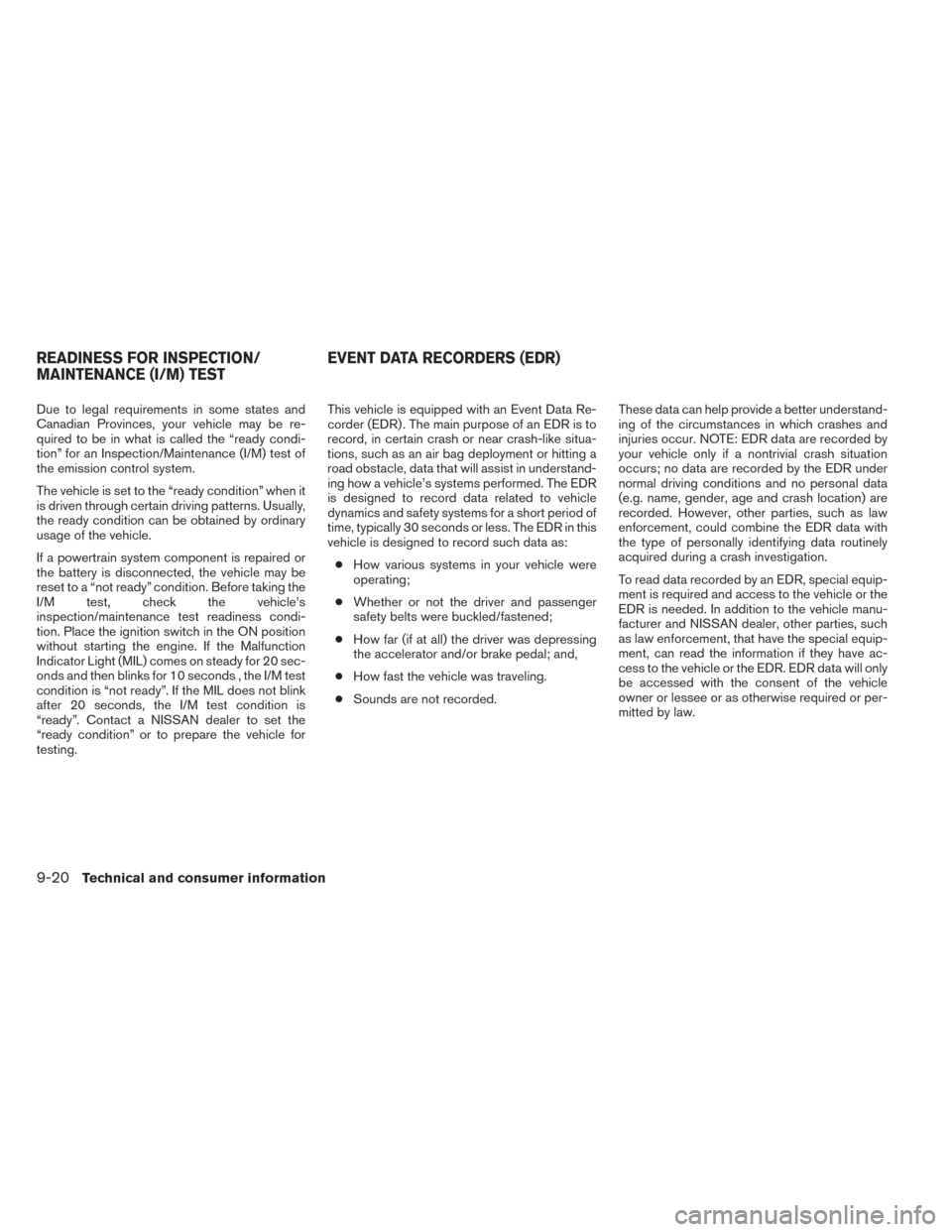
Due to legal requirements in some states and
Canadian Provinces, your vehicle may be re-
quired to be in what is called the “ready condi-
tion” for an Inspection/Maintenance (I/M) test of
the emission control system.
The vehicle is set to the “ready condition” when it
is driven through certain driving patterns. Usually,
the ready condition can be obtained by ordinary
usage of the vehicle.
If a powertrain system component is repaired or
the battery is disconnected, the vehicle may be
reset to a “not ready” condition. Before taking the
I/M test, check the vehicle’s
inspection/maintenance test readiness condi-
tion. Place the ignition switch in the ON position
without starting the engine. If the Malfunction
Indicator Light (MIL) comes on steady for 20 sec-
onds and then blinks for 10 seconds , the I/M test
condition is “not ready”. If the MIL does not blink
after 20 seconds, the I/M test condition is
“ready”. Contact a NISSAN dealer to set the
“ready condition” or to prepare the vehicle for
testing.This vehicle is equipped with an Event Data Re-
corder (EDR) . The main purpose of an EDR is to
record, in certain crash or near crash-like situa-
tions, such as an air bag deployment or hitting a
road obstacle, data that will assist in understand-
ing how a vehicle’s systems performed. The EDR
is designed to record data related to vehicle
dynamics and safety systems for a short period of
time, typically 30 seconds or less. The EDR in this
vehicle is designed to record such data as:
● How various systems in your vehicle were
operating;
● Whether or not the driver and passenger
safety belts were buckled/fastened;
● How far (if at all) the driver was depressing
the accelerator and/or brake pedal; and,
● How fast the vehicle was traveling.
● Sounds are not recorded. These data can help provide a better understand-
ing of the circumstances in which crashes and
injuries occur. NOTE: EDR data are recorded by
your vehicle only if a nontrivial crash situation
occurs; no data are recorded by the EDR under
normal driving conditions and no personal data
(e.g. name, gender, age and crash location) are
recorded. However, other parties, such as law
enforcement, could combine the EDR data with
the type of personally identifying data routinely
acquired during a crash investigation.
To read data recorded by an EDR, special equip-
ment is required and access to the vehicle or the
EDR is needed. In addition to the vehicle manu-
facturer and NISSAN dealer, other parties, such
as law enforcement, that have the special equip-
ment, can read the information if they have ac-
cess to the vehicle or the EDR. EDR data will only
be accessed with the consent of the vehicle
owner or lessee or as otherwise required or per-
mitted by law.
READINESS FOR INSPECTION/
MAINTENANCE (I/M) TEST
EVENT DATA RECORDERS (EDR)
9-20Technical and consumer information
Page 366 of 372
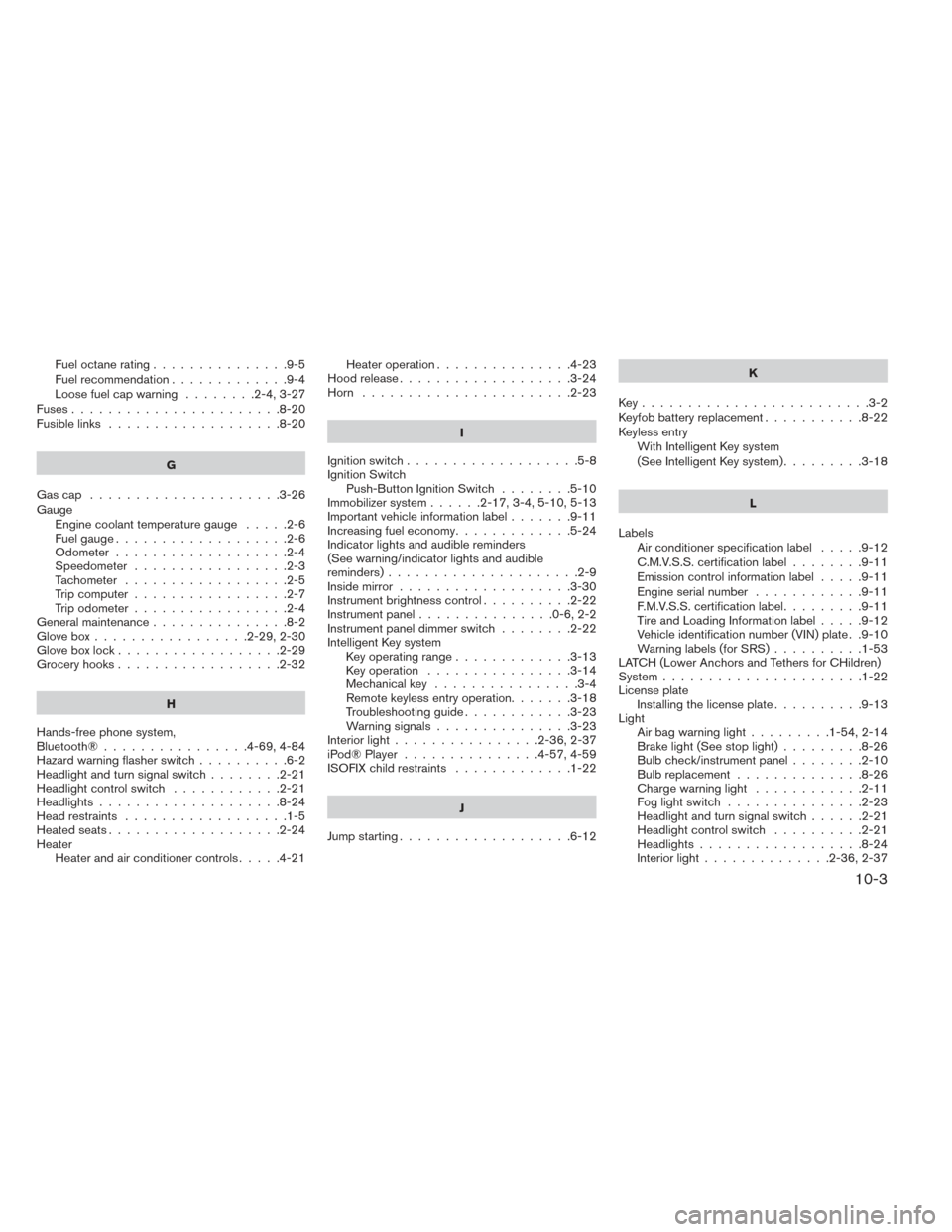
Fueloctanerating...............9-5
Fuel recommendation.............9-4
Loosefuelcapwarning ........2-4,3-27
Fuses.......................8-20
Fusiblelinks ...................8-20
G
Gascap .....................3-26
Gauge Engine coolant temperature gauge .....2-6
Fuel gauge ...................2-6
Odometer ...................2-4
Speedometer .................2-3
Tachometer ..................2-5
Trip computer .................2-7
Trip odometer .................2-4
Generalmaintenance...............8-2
Glovebox.................2-29,2-30
Gloveboxlock..................2-29
Grocery hooks ..................2-32
H
Hands-free phone system,
Bluetooth®................4-69,4-84
Hazard warning flasher switch ..........6-2
Headlightandturnsignalswitch........2-21
Headlightcontrolswitch ............2-21
Headlights....................8-24
Head restraints ..................1-5
Heated seats ...................2-24
Heater Heater and air conditioner controls .....4-21Heater operation
...............4-23
Hood release ...................3-24
Horn .......................2-23
I
Ignition switch ...................5-8
Ignition Switch Push-Button Ignition Switch ........5-10
Immobilizer system ......2-17,3-4,5-10,5-13
Important vehicle information label .......9-11
Increasing fuel economy .............5-24
Indicator lights and audible reminders
(See warning/indicator lights and audible
reminders).....................2-9
Inside mirror ...................3-30
Instrument brightness control ..........2-22
Instrument panel ...............0-6,2-2
Instrument panel dimmer switch ........2-22
Intelligent Key system Key operating range .............3-13
Key operation ................3-14
Mechanicalkey ................3-4
Remote keyless entry operation .......3-18
Troubleshooting guide ............3-23
Warning signals ...............3-23
Interiorlight................2-36,2-37
iPod® Player ...............4-57,4-59
ISOFIX child restraints .............1-22
J
Jump starting ...................6-12 K
Key.........................3-2
Keyfob battery replacement ...........8-22
Keyless entry With Intelligent Key system
(See Intelligent Key system) .........3-18
L
Labels Air conditioner specification label .....9-12
C.M.V.S.S. certification label ........9-11
Emission control information label .....9-11
Engine serial number ............9-11
F.M.V.S.S. certification label .........9-11
Tire and Loading Information label .....9-12
Vehicle identification number (VIN) plate . .9-10
Warning labels (for SRS) ..........
1-53
LATCH (Lower Anchors and Tethers for CHildren)
System ......................1-22
License plate Installing the license plate ..........9-13
Light Airbagwarninglight.........1-54, 2-14
Brake light (See stop light) .........8-26
Bulb check/instrument panel ........2-10
Bulbreplacement..............8-26
Chargewarninglight ............2-11
Fog light switch ...............2-23
Headlightandturnsignalswitch......2-21
Headlight control switch ..........2-21
Headlights..................8-24
Interiorlight..............2-36,2-37
10-3
Page 368 of 372
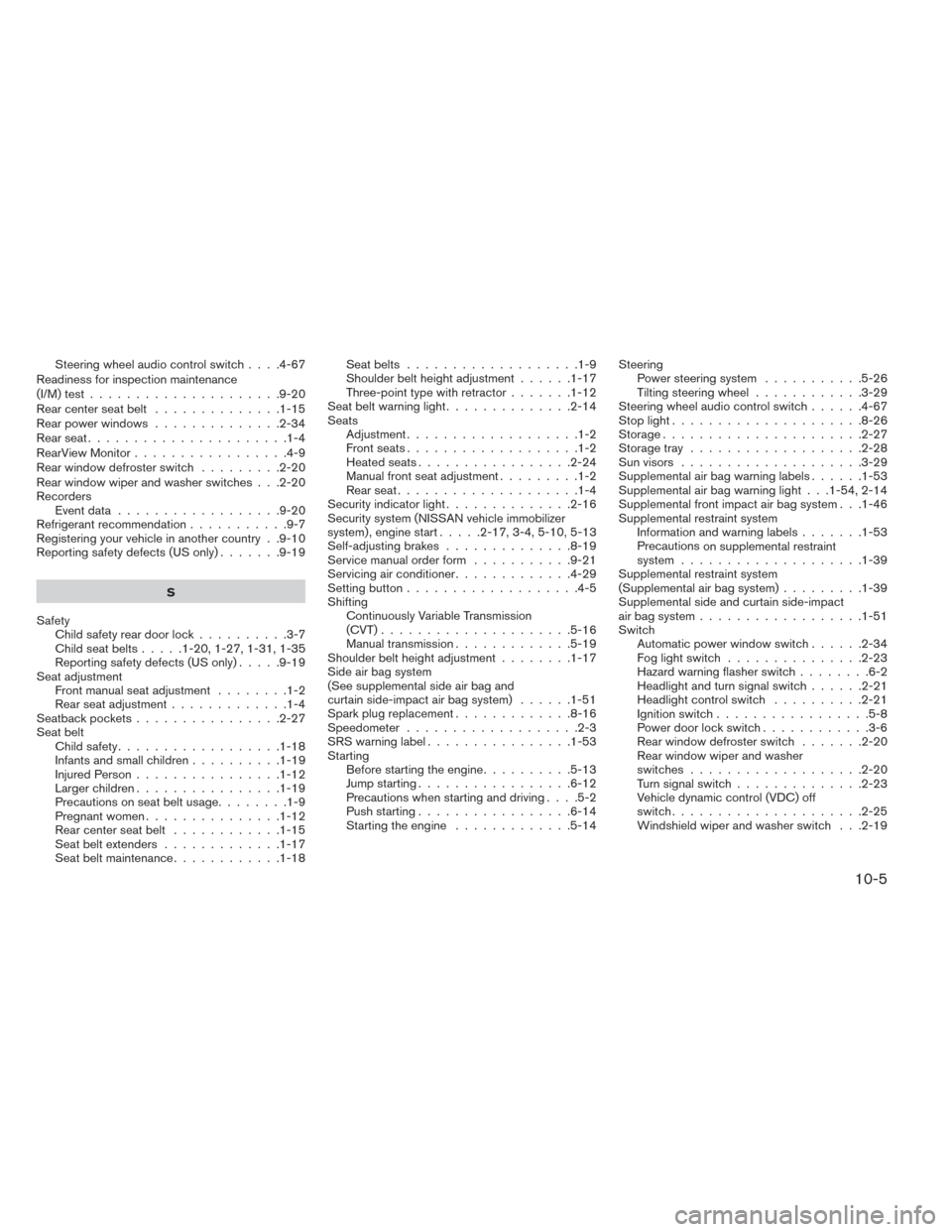
Steering wheel audio control switch....4-67
Readiness for inspection maintenance
(I/M) test .....................9-20
Rearcenterseatbelt ..............1-15
Rear power windows ..............2-34
Rearseat......................1-4
RearViewMonitor.................4-9
Rear window defroster switch .........2-20
Rear window wiper and washer switches . . .2-20
Recorders Eventdata..................9-20
Refrigerant recommendation ...........9-7
Registering your vehicle in another country . .9-10
Reporting safety defects (US only) .......9-19
S
Safety Child safety rear door lock ..........3-7
Childseatbelts.....1-20,1-27,1-31,1-35
Reporting safety defects (US only) .....9-19
Seat adjustment Front manual seat adjustment ........1-2
Rear seat adjustment .............1-4
Seatback pockets ................2-27
Seat belt Childsafety..................1-18
Infantsandsmallchildren..........1-19
Injured Person ................1-12
Largerchildren................1-19
Precautionsonseatbeltusage........1-9
Pregnant women ...............1-12
Rear center seat belt ............1-15
Seat belt extenders .............1-17
Seat belt maintenance ............1-18 Seatbelts ...................1-9
Shoulder belt height adjustment
......1-17
Three-point type with retractor .......1-12
Seat belt warning light ..............2-14
Seats Adjustment ...................1-2
Frontseats...................1-2
Heatedseats.................2-24
Manual front seat adjustment .........1-2
Rearseat....................1-4
Security indicator light ..............2-16
Security system (NISSAN vehicle immobilizer
system) , engine start .....2-17,3-4,5-10,5-13
Self-adjusting brakes ..............8-19
Service manual order form ...........9-21
Servicing air conditioner .............4-29
Setting button ...................4-5
Shifting Continuously Variable Transmission
(CVT) .....................5-16
Manual transmission .............5-19
Shoulder belt height adjustment ........1-17
Side air bag system
(See supplemental side air bag and
curtain side-impact air bag system) ......1-51
Sparkplugreplacement.............8-16
Speedometer ...................2-3
SRSwarninglabel................1-53
Starting Before starting the engine ..........5-13
Jump starting .................6-12
Precautions when starting and driving ....5-2
Push starting .................6-14
Starting the engine .............5-14 Steering
Power steering system ...........5-26
Tilting steering wheel ............3-29
Steering wheel audio control switch ......4-67
Stoplight.....................8-26
Storage......................2-27
Storage tray ...................2-28
Sun visors ....................3-29
Supplemental air bag warning labels ......1-53
Supplemental air bag warning light . . .1-54, 2-14
Supplemental front impact air bag system . . .1-46
Supplemental restraint system Information and warning labels .......1-53
Precautions
on supplemental restraint
system ....................1-39
Supplemental restraint system
(Supplemental air bag system) .........1-39
Supplemental side and curtain side-impact
air bag system ..................1-51
Switch Automatic power window switch ......2-34
Fog light switch ...............2-23
Hazard warning flasher switch ........6-2
Headlightandturnsignalswitch......2-21
Headlight control switch ..........2-21
Ignition switch .................5-8
Power door lock switch ............3-6
Rearwindowdefrosterswitch .......2-20
Rear window wiper and washer
switches...................2-20
Turnsignalswitch..............2-23
Vehicle dynamic control (VDC) off
switch .....................2-25
Windshield wiper and washer switch . . .2-19
10-5